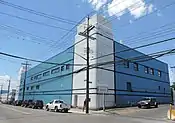Visual pollution
Visual pollution is an aesthetic issue and refers to the impacts of pollution that impair one's ability to enjoy a pleasant view. Visual pollution disturbs the visual areas of people by creating harmful changes in the natural environment. Billboards,[1][2] open storage of trash, antennas, electric wires, buildings, and automobiles are often considered visual pollution.

An overcrowding of an area causes visual pollution. Visual pollution is defined as the whole of irregular formations, which are mostly found in nature.[3][4]
Effects of exposure to visual pollution include distraction, eye fatigue, decreases in opinion diversity, and loss of identity.[3] It has also been shown to increase biological stress responses and impair balance.[5]
Sources

Local managers of urban areas sometimes lack control over what is built and assembled in public places. As businesses look for ways to increase the profits, cleanliness, architecture, logic and use of space in urban areas are suffering from visual clutter.[6] Variations in the built environment are determined by the location of street furniture such as public transport stations, garbage cans, large panels and stalls. Insensitivity of local administration is another cause for visual pollution. For example, poorly planned buildings and transportation systems create visual pollution. High-rise buildings, if not planned properly or sufficiently, can bring adverse change to the visual and physical characteristics of a city, which may reduce said city's readability.[3]
A frequent criticism of advertising is that there is too much of it.[6] Billboards, for example, have been alleged to distract drivers, corrupt public taste, promote meaningless and wasteful consumerism and clutter the land.[4] See highway beautification. However, with the introduction of new communication technologies, the fragmentation and incentive nature of advertising methods will improve, reducing clutter. Thus, with the increase of mobile device usage, more money goes to advertising on social media websites and mobile apps. Vandalism, in the form of graffiti is defined as street markings, offensive, inappropriate, and tasteless messages made without the owner's consent.[6] Graffiti adds to visual clutter as it disturbs the view.
Prevention
United States
In the United States, there are several initiatives gradually taking place to prevent visual pollution. The Federal Highway Beautification Act of 1965 limits placement of billboards on Interstate highways and federally aided roads. It has dramatically reduced the amount of billboards placed on these roads.[4] Another highway bill, the Intermodal Surface Transportation Efficiency Act (ISTEA) of 1991 has made transportation facilities sync with the needs of communities. This bill created a system of state and national scenic byways and provided funds for biking trails, historic preservation and scenic conservation.[7]
Businesses situated near an interstate can create problems of advertising through large billboards, however now an alternative solution for advertisers is gradually eliminating the problem. For example, logo signs that provide directional information for travelers without disfiguring the landscape are increasing and are a step toward decreasing visual pollution on highways in America.[7]
Brazil
In September 2006, São Paulo passed the Cidade Limpa (Clean City Law), outlawing the use of all outdoor advertisements, including on billboards, transit, and in front of stores.[8]
References
- Chmielewski, Szymon; Lee, Danbi J.; Tompalski, Piotr; Chmielewski, Tadeusz J.; Wężyk, Piotr (4 November 2015). "Measuring visual pollution by outdoor advertisements in an urban street using intervisibilty analysis and public surveys". International Journal of Geographical Information Science. 30 (4): 801–818. doi:10.1080/13658816.2015.1104316. S2CID 425572.
- Chmielewski, Szymon; Samulowska, Marta; Lupa, Michał; Lee, Danbi; Zagajewski, Bogdan (January 2018). "Citizen science and WebGIS for outdoor advertisement visual pollution assessment". Computers, Environment and Urban Systems. 67: 97–109. doi:10.1016/j.compenvurbsys.2017.09.001.
- Yilmaz, Demet; Sagsoz, Ayse (28 April 2011). "In the Context of Visual Pollution: Effects to Trabzon City Center Silhoutte". Asian Social Science. 7 (5). doi:10.5539/ass.v7n5p98.
- Nagle, John (1 January 2012). "Cell Phone Towers as Visual Pollution". Notre Dame Journal of Law, Ethics & Public Policy. 23 (2): 537. SSRN 1463592.
- Wibble, Tobias; Södergård, Ulrika; Träisk, Frank; Pansell, Tony (3 January 2020). "Intensified visual clutter induces increased sympathetic signalling, poorer postural control, and faster torsional eye movements during visual rotation". PLOS ONE. 15 (1): e0227370. doi:10.1371/journal.pone.0227370. PMC 6941927. PMID 31900468.
- Morozan, Cristian; Enache, Elena; Purice, Suzan (December 2012). "Visual Pollution: A New Axiological Dimension Of Marketing?" (PDF). Annals of the University of Oradea: 820–826. S2CID 151162637.
- Maguire, Meg; Foote, Ray; Vespe, Frank (30 September 1997). "Beauty as well as Bread". Journal of the American Planning Association. 63 (3): 317–328. doi:10.1080/01944369708975925. ProQuest 229617956.
- Curtis, Amy (8 December 2011). "Five Years After Banning Outdoor Ads, Brazil's Largest City Is More Vibrant Than Ever". New Dream.
External links
- "Visual Pollution - Albuquerque's Environmental Story". Friends of Albuquerque's Environmental Story.
- "Visual pollution". The Economist. 11 October 2007.
- "Seven Principles of Scenic Conservation". Scenic America. 18 September 2019.


